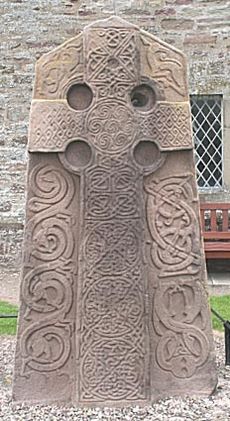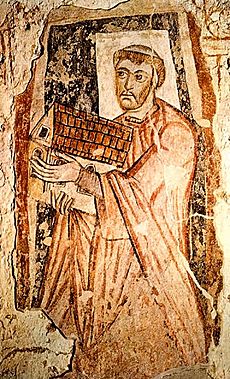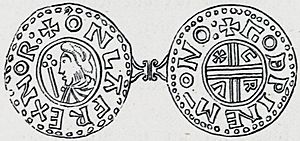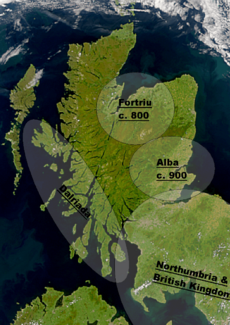Christianisation of Scotland facts for kids
The Christianisation of Scotland was a big change in history. It's how Christianity spread across what we now call Scotland. This happened mostly between the 400s and 900s AD.
Christianity likely first came to southern Scotland with Roman soldiers. These soldiers were stationed in the northern part of the Roman province of Britannia. After the Roman Empire lost its power in 410 AD, Christianity probably continued among the British people in the south of Scotland. However, it became less common as pagan Anglo-Saxons moved north.
Many stories say that St. Columba and other Irish missionaries converted Scotland from the 400s to the 600s. But many of these famous people came later. They often built monasteries in areas where Christianity was already present. Scholars have found a special kind of Celtic Christianity. In this type, abbots (heads of monasteries) were more important than bishops. Also, rules about priests getting married were more relaxed. There were also differences from Roman Christianity. These included how priests cut their hair (tonsure) and how they calculated Easter. Most of these differences were sorted out by the mid-600s.
After the Vikings in Scotland became Christian in the 900s, Christianity under the Pope became the main religion. This spread of Christianity was also important for Scotland's national identity. It led to Scottish and Irish missionaries going to Continental Europe. It also helped create Insular art and brought Latin and formal education to Scotland.
Contents
What was Religion Like Before Christianity?
Old Beliefs Before Christianity
Very little is known about religion in Scotland before Christianity arrived. There are no written records from the Picts themselves. So, we can only guess based on similar beliefs elsewhere. We also look at old objects found by archaeologists and what later Christian writers said. People generally think it was like Celtic polytheism, which means believing in many gods.
More than 200 Celtic gods have been mentioned. Some, like Lugh and The Dagda, come from later Irish stories. Others, like Teutatis and Cernunnos, are known from places like France. Celtic pagans built temples and shrines to worship these gods. They did this by offering gifts and performing sacrifices. Some of these sacrifices might have even involved humans.
Ancient Greek and Roman writers said that in France, Britain, and Ireland, there was a special group of priests called druids. We don't know much for sure about them. Irish legends and stories about St. Ninian connect the Picts with druids. Christian writings also link the Picts with "demon" worship. This might have been how Christians saw the Picts' gods. One story about St. Columba says he removed a demon from a well in Pictland. This suggests that worshipping well spirits was part of Pictish paganism.
How the Romans Influenced Scotland
Christianity in Scotland probably started with Roman soldiers and citizens. They lived near Hadrian's Wall. Old objects from the Roman period show that the northern parts of Roman Britain had many Christians. Symbols like the Chi-Rho (a Christian symbol) and Christian grave markers have been found on the wall from the 300s. Around the same time, Mithraic temples (called Mithraea) along Hadrian's Wall were attacked. Christians likely destroyed them.
Kingdoms After the Romans Left
After the Roman Empire lost its power in the early 400s, four main groups emerged in northern Britain. In the east, the Pictish kingdoms eventually stretched from the River Forth to Shetland. In the west were the Gaelic-speaking people of Dál Riata. They had strong connections with Ireland and brought the name "Scots" with them.
In the south were the British people. They were descendants of the Roman-influenced kingdoms of "The Old North." The strongest of these was Alt Clut. Finally, the Anglo-Saxons had taken over much of southern Britain. They held the Kingdom of Bernicia, which reached into what is now south-east Scotland.
While the Picts and Scots likely remained pagan, most experts believe Christianity survived among the British people after the Romans left. But it became less common as the Anglo-Saxons moved north. Anglo-Saxon gods included Tiw, Woden, Thor, and Frig. Their names are still used for days of the week. Eostre gave her name to the spring festival of Easter.
British Christians buried their dead without grave goods. But pagan Anglo-Saxons often burned bodies and buried them in urns. They also buried many objects with the dead, perhaps for the afterlife. Even though there's more evidence of Anglo-Saxon settlements in southern Scotland, only one such grave has been found, at Dalmeny in East Lothian.
How Christianity First Spread
British People and Christianity
Most experts agree that place names starting with eccles- (from the British word for church) show where the British church was during and after Roman times. In Scotland, most of these names are in the south. This is where the British kingdoms of the Old North were.
From the 400s and 500s, carved stones show Christianity through their dedications. These are found across southern Scotland. The oldest is the Latinus stone from Whithorn, from around 450 AD. A slightly later stone at Kirkmadrine mentions sacerdotes, which might mean bishops.
One key sign of Christianity spreading is cemeteries with long cists. These are stone-lined graves usually facing east–west, like Christian graves. These cemeteries are thought to be Christian because they are near a church or have Christian writings. They are found from the early 400s to the 1100s. Many are in eastern Scotland, south of the River Tay.
In the 500s, St. Patrick wrote about Coroticus, who probably ruled from Dumbarton rock. Coroticus had already accepted Christianity. The poem Y Gododdin, written around the early 500s, suggests that warriors from Gododdin (a kingdom near modern Edinburgh) were Christian. They received communion and confessed their sins before battle.
The story of St. Ninian, who is traditionally said to have brought Christianity to south-west Scotland, is now seen as a later invention. It might have come from confusing him with the Irish saint Finnian. The church called Candida Casa was dedicated to him at Whithorn in the 500s. From there, St. Kentigern seems to have started a new worship center at Govan or Inchinnan. This would spread influence across the Strathclyde region. However, it's clear that Christianity was already present in southern Scotland before the 500s.
Gaelic People and Christianity

The conversion of the Gaelic kingdom of Dál Riata in western Scotland is usually linked to St. Columba. But because of strong cultural and language ties with Ireland, which started becoming Christian in the 400s, Christianity probably reached this part of Scotland before Columba arrived in the mid-500s. In this view, the clergy loyal to Iona and other places helped strengthen Christianity and care for the people.
St. Columba was probably a student of Finnian. He left Ireland after being exiled and founded the monastery at Iona off Scotland's west coast in 563 AD. He likely received land from a Christian king. From Iona, missions went to western Argyll and the islands around Mull. Later, Iona's influence reached the Hebrides. Iona became the most important religious center in northern Britain. This was partly due to Adomnan, who was abbot there from 679 to 704. While it's unclear if the real Columba traveled much outside Dál Riata, Adomnan's Life of St. Columba made him seem like the main Christian leader for all of northern Britain.
Pictish People and Christianity
We don't know exactly how or how fast the Picts became Christian. Bede gives credit to Ninian for their conversion. This might be because in the 700s, when Bede was writing, the Anglo-Saxon kingdom of Northumbria controlled south-west Scotland. An English bishop was in charge of the area Ninian supposedly worked in. Bede might have been reminding the Pictish church of its loyalty.
Adomnan emphasizes Columba's role in Pictland. But even though Columba might have visited the area, Adomnan doesn't claim he converted many people. So, it's unlikely Columba had a huge impact. Another mission, possibly to spread Christianity in the north-east, was led by Columba's younger contemporary, Donnán of Eigg. Many churches in that region are named after him.

The process of conversion might have started earlier than the stories of famous missionaries suggest. Christianity likely reached the Picts from Dál Riata, with whom they had close connections through war, trade, and marriage. Stories place the 400s saint Palladius in Pictland after he left Ireland. They also connect Abernethy with his contemporary, Saint Brigid of Kildare.
Evidence for an early date for Christianisation includes St. Patrick's letter from the 400s. He mentioned "apostate Picts," meaning they had been Christian but left the faith. Also, the poem Y Gododdin doesn't describe the Picts as pagans. Recent archaeological work at Portmahomack shows that a monastery there was founded in the late 500s. This area was once thought to be one of the last to convert. In the east and north, Class II Pictish stones began to show Christian symbols from the early 700s.
Experts believe that the Pictish leaders became Christian over a long time, starting in the 400s and finishing in the 600s. The general population might have continued converting into the 700s. Place names suggest that Iona had a wide influence in Pictland. Many churches are dedicated to Iona abbots from the 600s.
Anglo-Saxon Influence on Christianity
In the 600s, St. Aidan (who died in 651) traveled from Iona. He founded a church at Lindisfarne off the east coast of Northumbria. Lindisfarne's influence spread through the kingdom of Northumbria into what is now south-east Scotland.
However, in the second half of the 600s, the Northumbrian church was more and more influenced by the Roman style of Christianity. The work of St. Wilfred (active from the 660s until his death in 709) and Benedict Biscop (around 628–690) strengthened ties with Rome. Wilfred was an abbot and Bishop of Northumbria. Benedict Biscop founded the monasteries of Jarrow and Wearmouth.
A bishopric (area led by a bishop) was set up at Abercorn in West Lothian. It is thought to have adopted Roman Christian practices after the Synod of Whitby in 664. At this meeting, King Oswiu of Northumbria agreed to Roman authority and practices. But the Pictish victory at the Battle of Dunnichen in 685 ended Northumbrian control of the region. The bishop and his followers were forced to leave.
How the Vikings in Scotland Became Christian

The official conversion of Viking-controlled Scotland happened in the late 900s. But there is evidence that Christianity had already started to spread in the Highland and Islands. Many islands are called Pabbay or Papa in the Western and Northern Isles. This might mean "hermit's" or "priest's isle" from this time. Changes in burial customs and Viking place names using "-kirk" also suggest Christianity was spreading before the official conversion.
According to the Orkneyinga Saga, written around 1230, Olav Tryggvasson, king of Norway, made the Northern Isles Christian in 995. He stopped at South Walls on his way from Ireland to Norway. The King called the local leader, Sigurd the Stout, and ordered him and his people to be baptized. He threatened to kill them and burn the islands if they refused. This story might not be entirely true. But the islands did officially become Christian, getting their own bishop in the early 1000s.
The bishopric was under the authority of the Archbishops of York and Hamburg-Bremen at different times. From the 1100s until 1472, it was under the Archbishop of Nidaros (now Trondheim). In other parts of Viking Scotland, the record is less clear. There was a Bishop of Iona until the late 900s. Then there was a gap of over a century, possibly filled by the Bishops of Orkney. The first Bishop of Mann was appointed in 1079.
One major effect of the Vikings becoming Christian was that they stopped raiding Christian sites. This might have allowed these sites to regain some of their importance as cultural and learning centers. It also probably reduced Viking violence and led to a more peaceful society in northern Scotland.
Why This Change Was Important

The Christianisation of Scotland brought the country into the main culture of Europe. When the Kingdom of Alba formed in the 800s, it was a clearly Christian kingdom. Even with its different cultures, religion became a major part of Scottish identity. The Canmore dynasty, which ruled Scotland from the 1000s to the late 1200s, saw itself as Christian. A strong link grew between the king and the church.
Accepting the Pope's authority meant that the Scottish church later faced claims of control from the archbishops of both Canterbury and York. Scotland's independent status in church matters was only confirmed by the Pope's special letter, Cum universi, in 1192.
Scottish monasteries also played a big part in the Hiberno-Scottish mission. Scottish and Irish clergy went on missions to the growing Frankish Empire. They founded monasteries, often called Schottenklöster (meaning Gaelic monasteries in German). Most of these became Benedictine monasteries in what is now Germany. Scottish monks, like St. Cathróe of Metz, became local saints in the region.
After the Picts converted and their culture blended with that of the Scots and Angles, a common art style appeared in Britain and Ireland. This was known as Insular art. Examples can be seen in metalwork, carvings, and especially in illuminated manuscripts. These books were highly decorated with complex patterns, like the Book of Kells. This book might have been made entirely or partly in Iona. Insular art became very influential in Europe, helping to develop Romanesque and Gothic styles.
Christianity also brought Latin to Scotland as a language for scholars and writing. Monasteries were important places for knowledge and education. They often ran schools and trained a small group of educated people. These people were vital for creating and reading documents in a society where most people could not read or write.
See also


